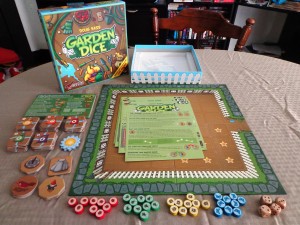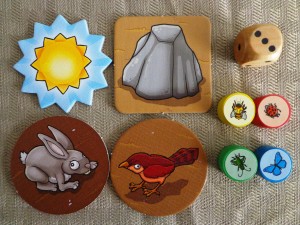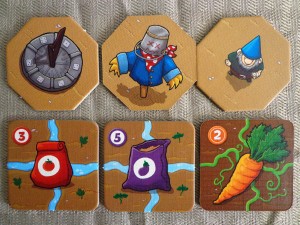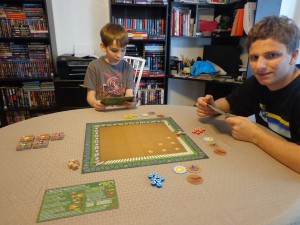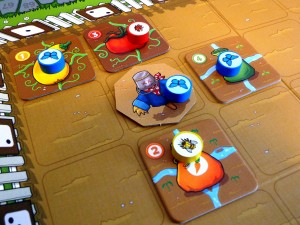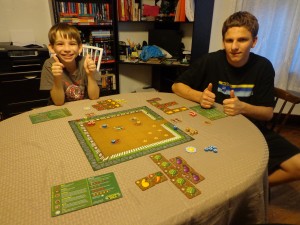What do you get when you throw a bunch of competitive gardeners onto the same patch of land and tell them to be the last gardener standing? I’m sure there’s some asinine reality show in the works for that kind of thing, but in the meantime, there’s something much better…Garden Dice.
Garden Dice is a mix of dice rolling and tile laying. Using both of those mechanics, players will be attempting to grow vegetables so that they can earn points. The catch is that they will all be sharing the same plot of land, so needless to say, it may get ugly. Before we take a look at the game in further detail, I’d like to thank Doug Bass from Meridae Games for sending me a free review copy. It should be noted that while the game hasn’t been released yet, the components that you will see represent the final components.
Components
Game Board – The center of the board is made up of a 6×6 grid, each space being a coordinate point for the row and column signs along its perimeter (each numbered one thru six). Some spaces have stars on them, which factor in during scoring. Along the perimeter of the board itself is a scoring track, in which players can keep track of their progress as they score points.
Seed / Veggie Tiles – These tiles are two-sided, one representing the seed side and the other representing the veggie side. Players will plant and harvest squash, carrots, tomatoes, artichokes, and eggplants.
Bird / Rabbit Tiles – These tiles are two-sided, move around the grid, and wreak havoc with seed and veggie tiles. (Birds eat seed tiles, rabbits eat veggie tiles)
Sundial / Scarecrow Tiles – These two-sided tiles give their owners special powers. The sundial can modify dice rolls that are used for the purpose of determining coordinates and the scarecrow can stop birds from eating surrounding seed tiles as well as provide a harvesting bonus.
Dice & Sun Tokens – Dice are rolled and used to perform various actions. Sun tokens are used to change the results of a dice roll.
Wooden Discs – There are nine discs of each color that players will use to mark their tiles. One of them will also be used as a scoring marker for the scoring track along the perimeter of the board.
Rock Tiles – These tiles are only used in the two player game to block spaces permanently.
Player Aids – One is given to each player to help remind them of the actions they can take, along with some other important rules to follow.
Gnome Tiles – These two-sided tiles are an optional game variant that adds modifiers to your dice rolls when performing specific actions.
Setup & Gameplay
The seed / veggie tiles are sorted by type and placed off to the side (seed side up). The number of tiles used in each stack is determined by the number of players. Each player receives a player aid, the discs of one color, a bird / rabbit tile, a sundial / scarecrow tile, a sun token, and if two players are playing, a rock tile. Players also receive a gnome tile if they are playing with the variant. Each player places one of their colored discs on the open path that leads to the garden…these discs will be moved along the scoring track as players earn points. The starting player is chosen randomly.
At the beginning of a player’s turn, they’ll roll all four dice. Using these dice, they’ll be able to perform the following actions:
1) Buy a Seed Tile – The current player can spend one die to buy a seed tile from the stacks. Each seed has a point value on it…the seed that the player purchases must have a value equal or lower than the die used to buy it. For example, a carrot seed has a point value of two on its tile…a die with a value of two or greater would be used to buy a carrot seed tile.
2) Place a Tile – The current player can spend two dice to place a special tile or a purchased seed tile onto an empty space on the board. The two dice spent represent the coordinates as to where this tile will be placed. The player will be able to choose which die will represent the row and which die will represent the column, so depending on the dice and the situation on the board, the player may have a few choices. Seed / veggie tiles are always placed seed side up, bird / rabbit tiles are always placed bird side up, and sundial / scarecrow tiles are always placed sundial side up.
3) Water a Seed – The current player can spend one die to water one of their own seed tiles. Just like when buying a tile, the die being spent must be equal or greater than the point value listed on the seed tile. Watering a seed tile can cause “chaining” to occur, or the watering of adjacent tiles regardless of ownership. Tiles that are adjacent to the tile being watered (not diagonally) and have a point value lower than it will also be watered. Chaining continues with each newly watered tile until there are no eligible, adjacent tiles that could be watered as part of the chaining process. Watered seed tiles are flipped to their veggie side.
4) Harvest a Veggie – The current player can spend a die to harvest one of their own veggie tiles. Veggie tiles claimed in this way are removed from the board and placed in front of the player, with points being scored equal to the point value on the tile. The scoring track is adjusted appropriately. If the current player harvests a veggie tile that is next to their scarecrow (includes diagonals), they earn an extra three bonus points. If the current player harvests a veggie tile that was on a star space, they earn double its point value. When both bonuses conflict, priority goes to the scarecrow bonus with the star bonus being ignored. Chaining also affects harvesting in the same way as it does with watering seeds…the owners of those veggie tiles take them and score points as if they themselves had harvested the tile(s) on their turn.
5) Flip a Special Tile – The current player may spend a die with a result of six to flip a special tile to the other side.
6) Move a Critter – The current player may spend a die to move a critter they own (remember to use those colored discs) in a straight line. The number of spaces moved can be equal to or lower than the die value spent. If possible, the critter can eat an opponents tile by landing on it (bird = seed, rabbit = veggie). The current player can either swallow the tile whole and remove it from the game (placing a colored disc on their critter in the process) or spend an unused die to spit out the seed, which is the equivalent of buying a seed tile.
7) Remove a Critter – The current player can remove ANY critter from the board by spending a total of three dice. One of them must be a six and the other two must correspond with the coordinates of the target critter’s location. The critter and its discs are returned to their rightful owner.
After an action is completed, the used dice are set aside and the current player can take another action, using the dice still available from the roll. After no more actions are possible (by running out of dice), the next player goes, and so on.
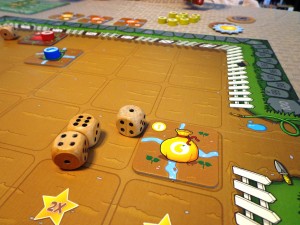
In this example, Vinnie bought a “1” seed with his “1” die, then placed it at coordinates “6”, “4” with his “6” and “4” dice.
The game ends when the last seed tile is taken from the last available stack. That player takes their turn and the game ends. Before scores are compared on the scoring track, bonus points are awarded or taken away for a number of different things. Players earn bonus points for sets they’ve completed (a group of all five types) and for having collections (a group of identical veggies), among other things. The player with the most points after factoring in these bonuses wins the game!
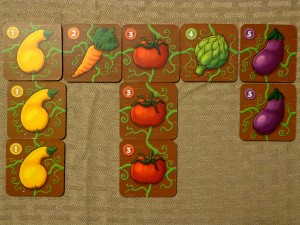
In this example, Anthony scored 15 points for having a set of five different veggies, then 20 points for the two groups of three veggies (10 each).
The above is simply an overview of the game, but should still give you an idea of how it is played. To see the rules in greater detail, the manual is available on the Garden Dice website here:
The Review
First, I must commend the game for having top-notch components and for coming with extra zip baggies. The latter always scores bonus points with me…kudos!
Before I touch on the strategy element, I’d like to mention that the game has a family game variant, which is listed in the manual. To implement this variant, all players have to do is remove the bird / rabbit tiles from the game. I like this variant because it allows parents to put a stop to unfair competitive play…that is…where one or more children may try to gang up on someone else. It also serves as a good way to introduce new or casual players to the game. The components themselves functioned well and the manual laid out the rules nicely. I didn’t have much trouble explaining the rules to the kids, though because of all of the actions available, I gave them a lot to think about. The player aids definitely helped in that regard.
Having a lot of options available however definitely adds a complexity to the game that I didn’t expect. We often took a minute after rolling the dice to see what all we could do and how that might affect someone else. It was obvious to everyone playing that it was best to plant, water, and harvest their seeds / veggie tiles as quick as possible lest critters take an interest in them, however we had to stop and think about how the chaining mechanic worked and how that might actually help someone else. I found myself waiting to water seeds at times until the kids had used their precious actions to water their own, as I didn’t want to give them free benefits unless I could help it.
The dice rolling mechanic reminded me a bit of Alien Frontiers, as I was often gauging what action I should take and in what order based on the results of the dice. While I was afraid that four dice might limit my ability to take actions, I found that there were plenty of different ways to spend them. Despite my dislike of dice, they actually served to balance the game out for all involved.
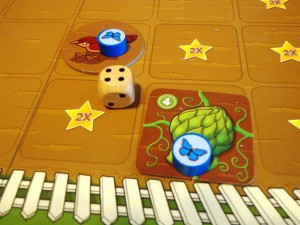
Still, with a little bit of planning, you can turn a four point veggie into an eight point veggie, which can make all the difference.
Anthony (16) and Vinnie (11) both had a lot of fun and took perverse pleasure in using their critters to eat my tiles. Where they had both taken an offensive stance, I was often choosing to buy seeds and plant them whenever possible. I made use of the scarecrow tile early on (when the dice allowed me to flip the sundial tile) to take a more defensive posture to stave off the advances of those hungry birds. They both caught on quickly and after a while, didn’t even need to consult their player aids. At that point, they knew what they needed to do without too much guidance from me. Still, new players should allow themselves a few games to get used to the many actions and mechanics.
Overall, Garden Dice was an enjoyable experience. The game is fairly deep in terms of gameplay but manages not to be too complex…the proverbial “sweet spot” if you will. There’s definitely enough here to keep us coming back for more, but is light enough to where we can pick up and play it within under an hour. I highly recommend that you parents out there give this particular game a once over to see if it would be a good fit for your family…it was for mine.
Final Verdict: 10/10
—
You can learn more about “Garden Dice” by visiting the following websites:
Garden Dice is expected to reach store shelves and be available for purchase online around mid-November. I’m told that the ability to pre-order will be available on the website mentioned above soon. So, with that said…let the best gardener win!
—

